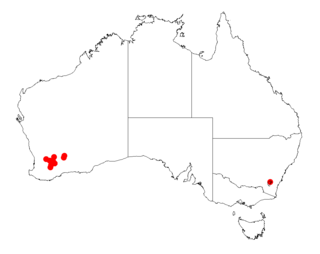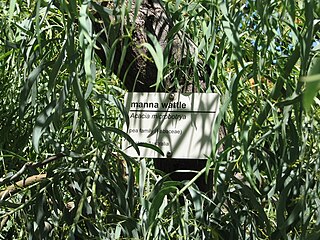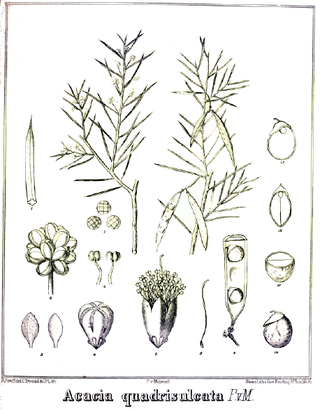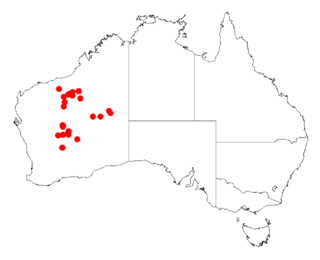
Acacia cyclops, commonly known as coastal wattle, cyclops wattle, one-eyed wattle, red-eyed wattle, redwreath acacia, western coastal wattle, rooikrans, rooikrans acacia, is a coastal shrub or small tree in the family Fabaceae. Native to Australia, it is distributed along the west coast of Western Australia as far north as Leeman, and along the south coast into South Australia. The Noongar peoples of Western Australia know the plant as wilyawa or woolya wah.

Acacia tumida, known colloquially as pindan wattle, spear wattle or wongai, is a species of Acacia native to northern and western Australia.

Acacia aciphylla is a species of flowering plant in the family Fabaceae and is endemic to the south-west of Western Australia. It is a bushy, prickly shrub with down-turned, rigid, sharply-pointed phyllodes, flowers arranged in a oval heads usually arranged in pairs in leaf axils, and linear pods up to 90 mm (3.5 in) long.

Acacia conniana is a shrub belonging to the genus Acacia and the subgenus Juliflorae that is endemic to the southern coast of western Australia.

Acacia gonocarpa, commonly known as wuluru, is a tree or shrub belonging to the genus Acacia and the subgenus Juliflorae. It is native to northern Australia.

Acacia inophloia, commonly known as fibre-barked wattle, is a tree or shrub belonging to the genus Acacia and the subgenus Juliflorae that is native to Western Australia.

Acacia kelleri is a tree or shrub belonging to the genus Acacia and the subgenus Juliflorae that is endemic to north western Australia.

Acacia sibina is a tree or shrub belonging to the genus Acacia and the subgenus Juliflorae the is endemic to parts of western Australia.

Acacia stipuligera is a tree or shrub belonging to the genus Acacia and the subgenus Juliflorae. It is native to arid and tropical parts of northern Australia.

Acacia trachycarpa, commonly known as minni ritchi, curly-bark tree, sweet-scented minni ritchi or Pilbara minni ritchi, is a shrub or tree belonging to the genus Acacia and the subgenus Juliflorae that is native to arid and semi-arid areas of Western Australia.

Acacia blakelyi is a shrub or tree belonging to the genus Acacia and the subgenus Phyllodineae.

Acacia celastrifolia, commonly known as the glowing wattle, is a shrub or tree belonging to the genus Acacia and the subgenus Phyllodineae native to Western Australia.

Acacia microbotrya, commonly known as manna wattle or gum wattle, is a shrub or tree belonging to the genus Acacia and the subgenus Phyllodineae that is native to Western Australia.

Acacia prainii, commonly known as Prain's wattle, is a shrub or tree belonging to the genus Acacia and the subgenus Phyllodineae endemic to Australia.

Acacia quadrisulcata is a shrub of the genus Acacia and the subgenus Phyllodineae endemic to Western Australia.

Acacia validinervia also commonly known as nyalanyalara, nyala nyala, alumaru or blue wattle, is a shrub of the genus Acacia and the subgenus Phyllodineae endemic to arid areas of inland Australia.

Acacia balsamea, commonly known as balsam wattle, is a shrub of the genus Acacia and the subgenus Plurinerves.

Acacia calcicola is a shrub or tree of the genus Acacia and the subgenus Plurinerves that is native to parts of central Australia. Common names for this species include; shrubby wattle, shrubby mulga, myall-gidgee, northern myall and grey myall. Indigenous Australians the Pitjantjatjara peoples know the tree as ikatuka, the Warlpiri know it as jirlarti and the Arrernte know it as irrakwetye.

Acacia oswaldii, commonly known as boree, umbrella wattle, umbrella bush, whyacka, middia, miljee, nella and curly yarran, is a shrub or tree of the genus Acacia and the subgenus Plurinerves.

Acacia pentadenia, commonly known as karri wattle, is a shrub or tree of the genus Acacia and the subgenus Pulchellae.




















